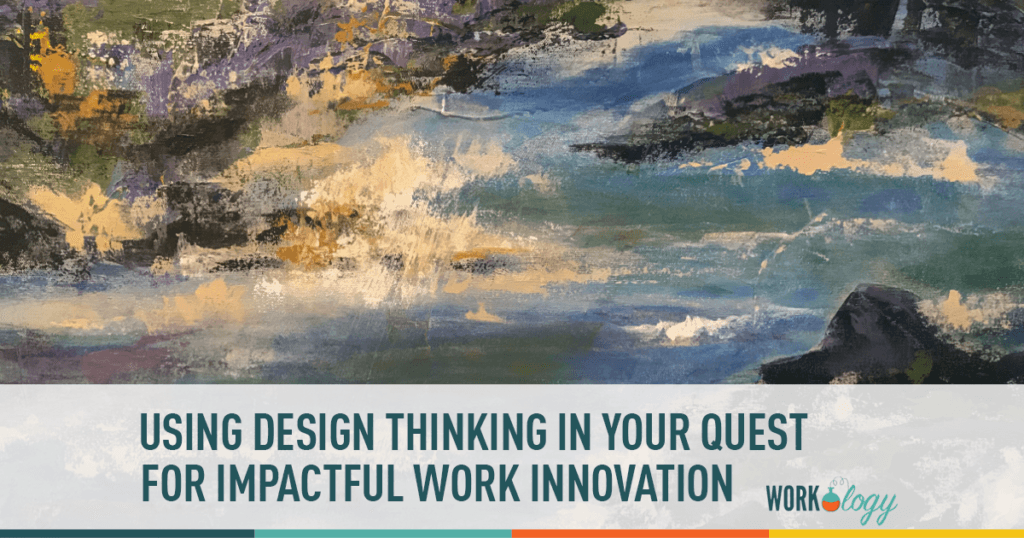Love our blog image? This art is by the talented Jane Flier of the Creative Art Society. Please show them some love and support independent artists.
Using Design Thinking in Your Quest for Impactful Innovation
If anything I bet you are a lot like me where your world is filled with calendar appointments, tasks lists and to do list exhaustion. The endless list of tasks to accomplish and problems to solve often put us in the unenviable position of working to enact solutions that don’t necessarily represent a huge value-add. That’s why design thinking is so interesting to me (and the rest of the world) right now. Well that, and these results from a survey by Deloitte:
“Respondents at companies where HR delivers the highest levels of value are almost five times more likely to be using design thinking in their programs than their peers.”
What Is Design Thinking and How Can It Be Used?
Though defined in nuanced ways by each industry, Design Thinking requires having the customer at the core of any product or service that’s being created or improved upon. It is human-centered, taking into account all the needs and concerns of the ultimate user. Engaging design thinking means getting to the heart of the user experience by deeply understanding the customer.
Traditionally applied to services, products, and business models, Design Thinking is having a moment in the HR realm. It feels like human-centric design is already part of what we do by the very nature of our roles. But that isn’t always the case. Sometimes we’re solving the problem without thinking about the issue as a whole. The design thinking approach isn’t solely focused on the problem—instead, it brings together an amalgamation of logic, reasoning, intuition, and imagination to explore all possible outcomes. By eliminating previously held assumptions and coming at the problem with multiple dimensions, it’s can be especially useful for tricky problems for which there isn’t a clear answer.
Design Thinking requires us to:
Empathize with users
Define users’ needs, problems, and our insights
Ideate through challenging assumptions
Prototype solutions
Test for viability
What I want to focus on here is the “challenging assumptions” part of the methodology. As HR professionals, we come to some of these steps naturally. For example, we’re likely to empathize often and easily. Challenging base assumptions is more difficult because #biology. Humans develop patterns of thinking based on repetition. This is built-in—a way for us to arrive at conclusions and solutions without working through all the preliminary steps every single time.
However, this biological bent can also prevent us from developing new ways of solutioning a problem. “This” worked in the past, so it’s something we should continue doing. Design Thinking asks us to analyze and understand how our customers actually interact with what they’re being offered, going so far as to ask us to prove that what we’ve done doesn’t work.
In doing so, we learn how to improve the product, service, or design. We get data points plus creative process, we get empathy and science, we get actionable numbers and innovation. It’s a blending of the numbers and the art. We’re all looking for ways to get an edge in this high-talent marketplace and the best way to get there is by innovating beyond the competition.
[bctt tweet=”69% of design-led firms perceive their innovation process to be more efficient as a function of design thinking. #designthinking #hr #shrm ” via=”no”]
In a study done by the Parsons New School, 69% of design-led firms perceive their innovation process to be more efficient as a function of design thinking. And it’s no wonder—the ideation phase built into design thinking is meant to bring out the best in brainstorming. Impractical ideas are welcome and encouraged, then prototyped and tested. From those, spring the seeds of innovative solutions, services, or products. There are often positive side effects of this rapid creative process including higher team engagement, improved morale, and ideas that spin off the original core issue.
There are countless examples of companies that couldn’t keep up—Nokia, Kodak, Blockbuster, JC Penney—who we now regard as behemoths of a bygone era. They didn’t innovate fast enough. And while you may not be rushing towards that particular fate, lack of innovation makes your company less attractive to new talent and certainly doesn’t benefit your current workforce. A frictionless workplace and innovation process that pushes forward change in HR is in the best interest of everyone organization.
5 Ways Design Thinking Can Be Used in Human Resources
As design thinking moves into the human resources and leadership space, I see design thinking being used and applied in HR the following ways:
Employee Engagement: Increase employee engagement through efficiency gains and creative enablement brought about by Design Thinking.
Digital Solutions: Understanding the user experience can drive creation of end-user tools that manage simple HR issues in the digital space.
Connection to the Customer: Exercising our understanding of employees’ needs (both met and unmet) informs the entire HR ecoystem.
Employee Personas: Developing recruiting and HR personas to represent segments of our customers uncover insights that may have been previously unrepresented.
Onboarding: Knowing more about the user experience can lower costs and increase onboarding efficacy.
Make the shift to design thinking in your organization. Deloitte’s research tells us that HR teams who use design thinking are five times more effective at adding value to their organizations. It’s something I’m really diving into right now. It’s been clearly proven to help foster innovation, find creative solutions, and uncover new opportunities for growth. Empathizing, understanding, and creating people-driven solutions for employees gives you the chance to approach something in a totally new way. And yes, while this likely results in that desired market advantage, it also brings us back to the “human” part of Human Relations.








